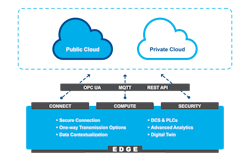As digital transformation matures, industry enters an exciting era of innovation

It has been fascinating watching as, over the last five years, conversations around process control and automation have focused almost exclusively on digital transformation. But in reality, digital transformation has been happening for far longer than five years. In fact, the modern distributed control system (DCS) has been digitally transforming operational technology (OT) for well over 20 years now. As a result, the DCS has become the most critical automation system in the plant, tying together all the equipment and software for improved process control performance, safety and reliability, and to create the core of the OT edge. However, the DCS also fundamentally evolved into a self-contained architecture.
Self-containment has worked well for decades, but times change, and essential systems continue to evolve. Another term commonly discussed in tandem with automation today — Industry 4.0 — is challenging the way automation experts look at their DCS, with increased focus on vertical integration. Smart technologies, the rise of cloud computing, cybersecurity improvements and a global marketplace have all forced an increased focus on collaboration at the edge between information technology (IT) and OT, creating the right environment for the IT/OT convergence.
Operating in, and essentially building the industrial edge, the DCS is evolving to take on a central role in IT/OT convergence, and the next steps on this journey will redefine the DCS as we know it, transforming the control system into an industrial operating system to bridge IT and OT.
Moving from controller-centric to data-centric
Today, operating without access to data and with no internet and cloud connectivity severely limits an organization’s opportunities for performance enhancement. When organizations begin a project, instead of starting with just process control and automation in mind, they often begin the design by considering Industry 4.0 and industrial internet of things (IIoT) connectivity, and by determining how to connect and manage data most effectively across the systems. Managing critical data from devices and the control system at the edge — and then moving that data to the enterprise for analysis, trending, forecasting and performance evaluation — requires tight collaboration between IT and OT to make the most of DCS edge capabilities.
Nearly all the data an organization needs should pass through the edge compute nodes of the DCS, so the control system should always be a part of this conversation. However, traditional methods to bring data to the DCS often created complications. First and foremost, all the data connected to the DCS traditionally passed through controllers, which added cost and complexity to the design.
But new strategies, software and technologies emerging in the marketplace — as well as commercial and sustainability incentives — are among the catalysts for evolving the DCS from a hierarchical architecture to a hyper-integrated cloud model connecting data everywhere.
Solutions designed for rapid, intuitive connectivity, such as Ethernet I/O cards, are making it easier for teams to bring data from a multitude of devices into the DCS software without going through controllers. Modular and redundant, these cards easily connect to Ethernet devices for better visibility of plant performance using flexible, modular, modern and cost-effective networking technology familiar to both OT and IT users.
New technologies like Ethernet advanced physical layer (APL) and OPC UA will further simplify the data flow to and through the DCS, allowing it to move from the field directly to the DCS applications and beyond, without needing to go through the controllers.
To help teams drive their newly collected data to higher-level enterprise systems, other new technologies simplify connectivity while simultaneously improving cybersecurity. One key emerging technology is OT edge gateways. While today’s available edge gateways operate above the DCS, collecting data and making it available, they lack the proper integration for data contextualization and extra cyber security features necessary for truly integrated operations.
New OT edge technology is on the horizon, however, offering intuitive, secure integration via one-way transmission using a data diode. These solutions collect data from the control system, delivering it to automation and process engineers — via integrated software solutions designed for the OT team — and more widely to IT systems on premises or in the cloud (Figure 1). Secure OT edge gateways can connect with advanced, mobile human machine interfaces to display standard control data alongside optimization details to help cross-functional teams collaborate for improved performance.
Building secure connectivity to the outside world
There is a dichotomy in the process automation industry. For decades, there have been perceived dangers when connecting to the cloud because of the risks to safety and security. Yet, as OT teams have shied away from cloud technologies that could improve enterprise visibility, efficiency and performance, much of the commercial world has connected its most valuable assets to the cloud. Today, nearly everyone has money, personal data and livelihoods in the cloud as banks, home automation systems, security systems, vehicles and more are connected to the cloud 24x7. Cybersecurity conditions have improved to the point that we can now start connecting mission-critical assets.
As this shift to a connected world has taken place in people’s personal lives, a very similar shift has taken place in the personnel operating plants. Today’s plant personnel are evolving into digital natives. Connected technologies invade every aspect of their lives. Moreover, many IT staff have a much better understanding of process control and automation, while many OT personnel have a range of IT and other programming skills.
As a result, the new industrial innovators are not considering how they can distance the control system from the cloud, but instead how they can leverage the DCS’s edge infrastructure to build cloud-connected plants ready to reap the benefits of Industry 4.0.
Tomorrow’s industrial operations and the people who come to define them will need and expect greater connectivity at the edge. The industrial edge connects more of the plant floor to the cloud every day, and the DCS is a critical part of that equation. However, cybersecurity is in no way a throwaway concern. As the need for a more connected, holistic edge environment increases, the DCS will continue to evolve to include built-in secure connectivity as a standard (Figure 2).
For plants needing only to expose DCS data to the outside world for collection by enterprise systems, one-way data diodes are already providing cybersecure data visibility from the plant to the cloud. But other solutions for more comprehensive data exchanges between the DCS and the cloud are also emerging, like the User Association of Automation Technology in Process Industries’ (NAMUR’s) Verification of Request. In the near future, the DCS will evolve to support protocols outside the common industrial protocols supported nearly exclusively today. Support for REST API, MQTT and modern IIoT protocols such as OPC UA are helping modern control systems embrace connectivity, while maintaining cybersecurity.
In addition, the DCS will continue to evolve to support new cybersecurity strategies, such as zero-trust architecture, removing the default trust for network devices and requiring explicit and continuously-verified validation of credentials at all times.
Extending the DCS to an automation sandbox
Typically, extensibility is considered an IT concept, but in the coming years, the DCS will further blend into the IT space as it adds more open connectivity for customization and collaboration.
Today’s control systems are more than just distributed control architectures, they are also automation platforms providing connectivity to the tools personnel need to run the plant safely, efficiently, sustainably and reliably. But DCS platforms must also meet the needs of many different industries, and even a wide variety of use cases within each individual industry. That wide spectrum of applications, coupled with the fact that users are more technologically savvy than ever before, has created an environment where the need for unique apps has outstripped the capacity for control system manufacturers to provide them all.
To meet this need, automation providers will begin evolving their platforms to function as extensible sandbox environments so external entities can create their extensions of the DCS through secure APIs.
Custom apps created by users, such as a chemical analytics package that is mission specific for a small group of process plants, will become commonplace, enabling end users to not only improve their own environments, but to also contribute value across their industries. And the same technologies can be used to develop solutions to reduce time spent on capital projects.
Tomorrow’s DCS is on the way
This is the most exciting time for automation in decades. Industry 4.0 has shown the benefits of a connected edge, and current advancements in technology are evolving the DCS to bridge the gaps, and to foster collaboration and innovation between IT and OT. As the control system evolves with a more data-centric, app-enabled architecture — and provides connectivity in a secure way that is easy for anyone to use — users will be more involved than ever in defining the capabilities of automation.
Claudio Fayad serves as vice president of technology of Emerson’s Process Systems and Solutions business. Prior to this role, he held a variety of positions within Emerson from sales and marketing director to vice president of software. He joined Emerson as director of Process Systems and Solutions in May of 2006 based in Brazil. He holds a bachelor’s degree in engineering from the Universidade Estadual de Campinas and a master’s degree in business administration from Northwestern University.
Emerson
About the Author
Claudio Fayad
Vice president of technology of Emerson’s Process Systems and Solutions business
Claudio Fayad serves as vice president of technology of Emerson’s Process Systems and Solutions business. Prior to this role, Claudio held a variety of positions within Emerson from sales and marketing director to vice president of software. He joined Emerson as director of Process Systems and Solutions in May of 2006 based in Brazil. Before Emerson, he started his career with Smar in 1995 as systems engineer and progressed through various roles of sales. Claudio served as the global engineering sales director in his last role with Smar. Claudio holds a bachelor’s degree in engineering from the Universidade Estadual de Campinas and a master’s degree in business administration from Northwestern University.
